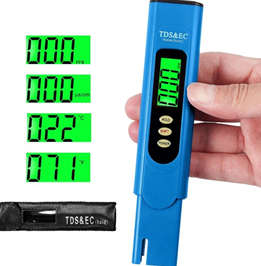- An electrical conductivity or total dissolved solids meter is a quick method to estimate total dissolved solids in water and determine water quality.
- Total dissolved solids (TDS), also known as total dissolved salts, are dissolved minerals that are constantly present in water. In sufficient quantities, certain of these minerals can be poisonous.
- The typical procedure for calculating TDS in the lab involves completely evaporating the water from a 0.1-liter sample and weighing the remaining minerals in the container. However, the process of gathering a sample and waiting for a lab analysis can be time-consuming.
- One quick way to determine TDS is to use an electrical conductivity (EC) or TDS meter. The dissolved minerals (ions) in water are what truly conduct the electricity, albeit water itself does conduct electricity. Since pure (distilled) water conducts electricity very poorly, the more dissolved minerals there are in the water, the more conductible it becomes.

What is TDS in Water?
- Total Dissolved Solids. The term “TDS in water” refers to the total dissolved solids (TDS) content of your tap water. The minerals in the rocks and soil that it passes over or through are dissolved by the rainwater after it has fallen to the earth. These minerals remain in the water at various concentrations as they dissolve. By gradually raising the pH of the water, this extremely natural process aids in giving the water a “proper” taste. The most prevalent minerals in water are salt, calcium, and magnesium.
- TDS measurements are often given in milligrams per liter (mg/l), which is equivalent to parts per million (ppm). A part per thousand (ppt), or 1,000 parts per million (ppm), is how certain meters display TDS.
What is EC in Water?
- The electrical conductivity (EC) of a material, or how well a liquid can transport an electric current through it, is measured. Water in its natural condition, such as rain, lake water, rivers, etc., will typically have a low amount of EC when looking at EC in water or liquid (pure water has no EC). The EC of a body of water will vary when it is contaminated, polluted, or contains contaminants because the dissolved materials raise the EC level. As a result, EC can be a reliable sign of water pollution. However, it should be noted that because seawater has a lot of dissolved salt, contaminants like salt might result in extremely high EC readings. This is due to the separation of ions that occurs when salt is dissolved (electrically charged atoms).
- The EC is a stand-in measurement for TDS in water. The fact that EC can be stated in several units contributes to some of the confusion when using it. Micromhos per centimeter (mhos/cm) and millimhos per centimeter (mmhos/cm) are two possible abbreviations for the units, as are micro siemens per centimeter (S/cm) and milliSeimens per centimeter (mS/cm). Consequently, 1,000 mhos/cm = 1,000 S/cm (1 mm/cm = 1 mS/cm).
Working Principle of TDS and EC Digital LCD Meter Conductivity Sensor
- The basic method used by equipment to measure conductivity is to place two plates in the sample, apply a potential across the plates (often a sine wave voltage), and then measure the current flowing through the solution. According to Ohm’s law, conductivity (G), the inverse of resistivity (R), can be calculated from the voltage and current values.
- The conductivity of a solution is inversely related to its ion concentration because the charge on ions in the solution facilitates the conductance of electrical current.
- The total dissolved solids increase the electrical conductivity (EC) of a water solution. Because EC is a measure of dissolved solids in your water supply, it can be used to calculate TDS.
- To determine the actual TDS value, you must multiply the EC value by 1000 and divide that number by 2. To calculate the EC value, multiply the ppm value by 2 and divide by 1000.
Applications of TDS and EC Digital LCD Meter Conductivity Sensor
- Water quality testing. The applications of this instrument in water analysis cannot be overstated. It is used to test water purity, conduct water pollution surveys, measure water salinity, and treat wastewater.
- Used in the transportation industry to test the strength of heat-treated materials.
- Conductivity testing of copper and aluminum, as well as other non-ferrous metals, in industrial processes, particularly in electrical engineering.
- For checking conductivity during the aluminum anodizing process in metal industries.
- Corrosion and leakage monitoring.
Advantages of TDS and EC Digital LCD Meter Conductivity Sensor
- It’s adaptable and can be used to test the quality of solids, gases, and liquids.
- High measurement accuracy yields stable and repeatable results.
- It is simple to use and portable, so it can be used on a tabletop or in the field.
- It is simple to calibrate and maintain.
- Used in a wide pressure and temperature range.
